The AMD Radeon RX Vega 64 & RX Vega 56 Review: Vega Burning Bright
by Ryan Smith & Nate Oh on August 14, 2017 9:00 AM ESTPower, Temperature, & Noise
Moving on from performance metrics, we’ll touch upon power, temperature, and noise. This is also normally where we’d discuss voltages, but as Vega is a new chip on a new architecture, nothing seems to read Vega 64 and 56 correctly.
In terms of average game clockspeeds, neither card maintains its boost specification at 100% with prolonged usage. Vega 64 tends to stay closer to its boost clocks, which is in line with its additional power overhead and higher temperature target over Vega 56.
| Radeon RX Vega Average Clockspeeds | ||
| Radeon RX Vega 64 Air | Radeon RX Vega 56 | |
| Boost Clocks |
1546MHz
|
1471MHz
|
| Max Boost (DPM7) |
1630MHz
|
1590MHz
|
| Battlefield 1 |
1512MHz
|
1337MHz
|
| Ashes: Escalation |
1542MHz
|
1354MHz
|
| DOOM |
1479MHz
|
1334MHz
|
| Ghost Recon: Wildlands |
1547MHz
|
1388MHz
|
| Dawn of War III |
1526MHz
|
1335MHz
|
| Deus Ex: Mankind Divided |
1498MHz
|
1348MHz
|
| GTA V |
1557MHz
|
1404MHz
|
| F1 2016 |
1526MHz
|
1394MHz
|
| FurMark |
1230MHz
HBM2: 868MHz |
1099MHz
HBM2: 773MHz |
With games, the HBM2 clocks ramp up and stay at their highest clock state. Expectedly, the strains of FurMark cause the cards to oscillate memory clocks: between 945MHz and 800MHZ for Vega 64, and between 800MHz and 700MHz for Vega 56. On that note, HBM2 comes with an idle power state (167MHz), an improvement on Fiji's HBM1 single power state. Unfortunately, the direct power savings are a little obscured since, as we will soon see, Vega 10 is a particularly power hungry chip.
As mentioned earlier, we used the default out-of-the-box configuration for power: Balanced, with the corresponding 220W GPU power limit. And under load, Vega needs power badly.
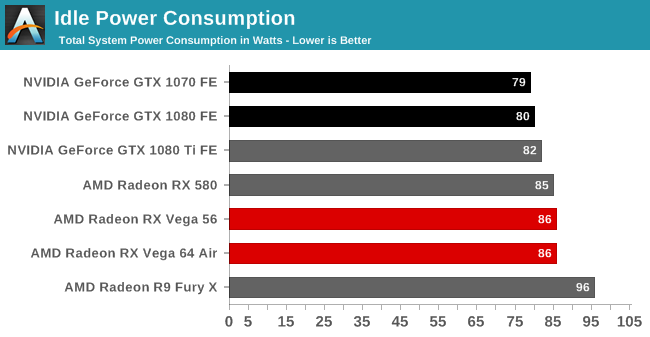
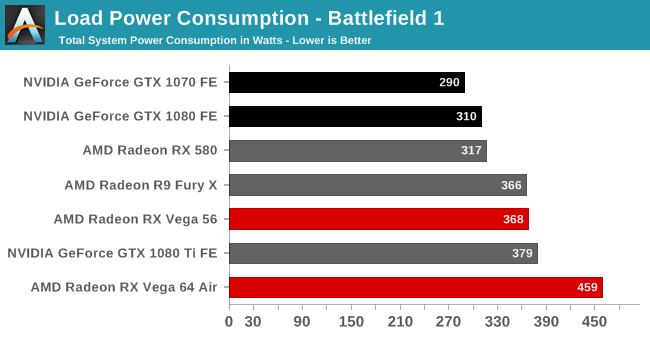
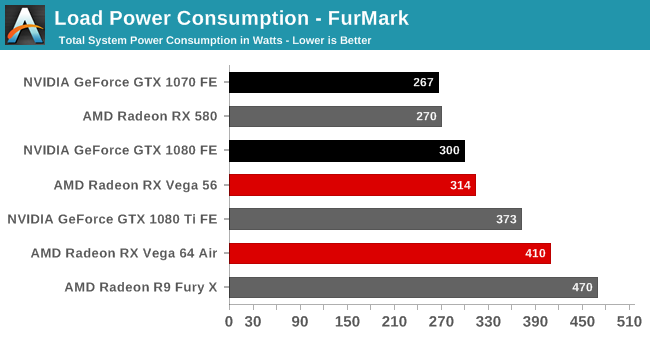
The performance of both Vega cards comes at a significant power cost. For the RX 500 series, we mused that load consumption is where AMD paid the piper. Here, the piper has taken AMD to the cleaners. In Battlefield 1, Vega 64 consumes 150W more system-wide power than the GTX 1080, its direct competitor. To be clear, additional power draw is expected, since Vega 64 is larger in both shader count (4096 vs. 2560) and die size (486mm2 vs. 314mm2) to the GTX 1080. But in that sense, when compared with the 1080 Ti, powered by the 471mm2 GP102, Vega 64 still consumes more power.
As for Vega 64's cut-down sibling, Vega 56's lower temperature target, lower clocks, and lower board power make its consumption look much more reasonable, although it is still well above the 1070.
In any case, the cooling solutions are able to do the job without severe effects on temperature and noise. As far as blowers go, RX Vega 64 and 56 are comparable to the 1080 Ti FE blower.
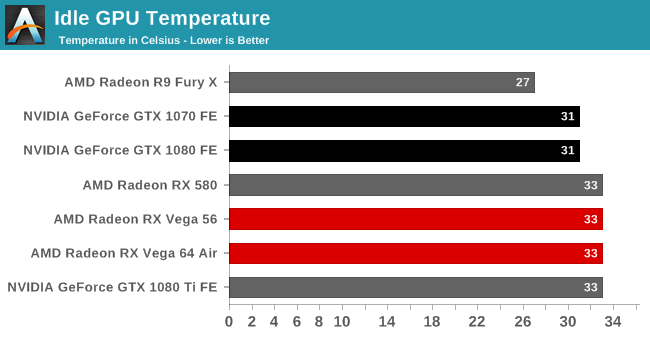
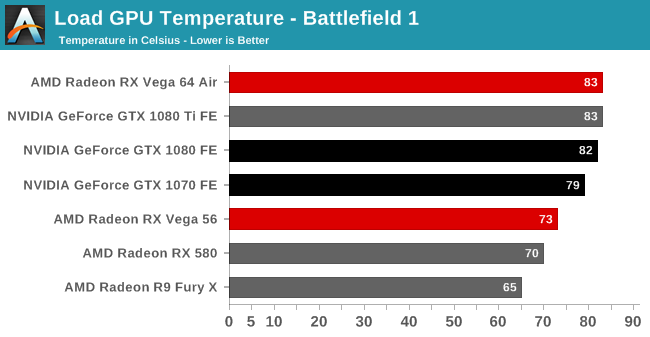

Not Graphed: Temperature of the actual Vega (Star): 9329C
Noise-testing equipment and methodology differ from past results, with a more sensitive noise meter and closer distance to the graphics card. Readings were also taken with an open case. As such, the noise levels may appear higher than expected.

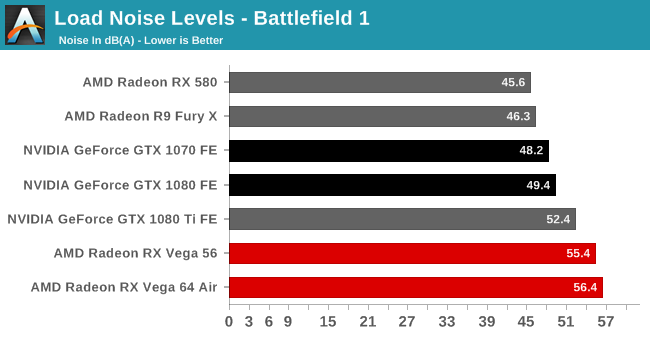
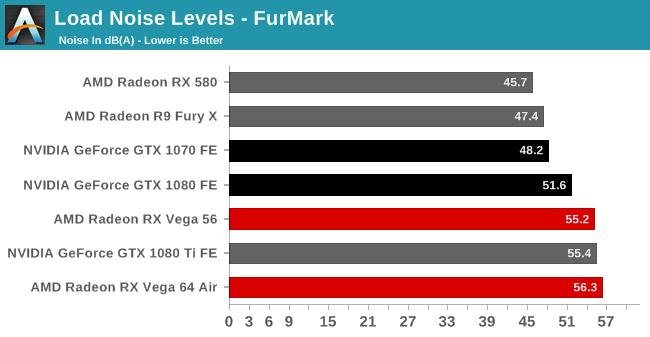










213 Comments
View All Comments
msroadkill612 - Monday, August 14, 2017 - link
Anyone who is kinda meh about a vega 56 or a 1070, and plans a ryzen rig, is mad not to get the sibling vega imo.Synergies are bound to pay dividends for some time to come.
Leyawiin - Monday, August 14, 2017 - link
lol - "synergies". That was disproved years ago.mapesdhs - Monday, August 14, 2017 - link
I remember the days when tech sites were investigating why NV cards seemed to run better on AMD hw, think it was back in the P67 days or somesuch. The issue faded away, but it proved there's not necessarily a benefit to having all the tech from one side of the fence.beast6228 - Monday, August 14, 2017 - link
AMD pulled an Nvidia on this one, that touted $499 ended up being $599 and there was very limited supply on launch. I went to Microcenter and they only had 4 cards, 2 Gigabytes and 2 XFX. When I saw the $599 I was like, you can buy a faster, cooler and less power hungry 1080 for $100 less. This performance does not warrant this high price, sorry AMD you failed pretty hard.coolhardware - Monday, August 14, 2017 - link
Glad to hear Microcenter at least had *some* stock. Everywhere seems out now and I am just wondering when Amazon is going to finally pull the trigger on their cards and bundles!Aldaris - Monday, August 14, 2017 - link
How is it AMD's fault sellers are ignoring RRP?mapesdhs - Monday, August 14, 2017 - link
$750 in the UK (equivalent). AMD is responsible for the hype though, and thus arguably for the demand, so if they can't meet the supply then sellers can spike the prices to exploit the demand. Economics 101. AMD must have known that either the power/noise behaviour wasn't so good, or the supply could not be met. They're not directly responsible, but the resulting pricing should not be a surprise. Those buying them at inflated prices are just the ones who either don't know about the performance/power/noise issues or don't care (Vega64 performs better than I expected, but at 20% more expensive than a 1080 FE it makes no sense. Heck, for the cost of a 64/Liquid in the UK one can get a 1080 Ti.BrokenCrayons - Monday, August 14, 2017 - link
GPU power consumption was already too high before Vega's release. I think it's a mistake to raise that already high bar even higher.Smell This - Monday, August 14, 2017 - link
Good for AMD.You guys touched on it, but this is TSMC 28nm 'big chip' shrunk to GloFo 14nm LPP. Impressive 15% smaller with nearly 50% more transistors.
And, it seems to me with the Infinity Fabric the next logical step is Zen+HBM2+Stars.
Make it so, Dr Su!
FreckledTrout - Monday, August 14, 2017 - link
Or vega + vega + HBM2 on a 7nm process aka Navi